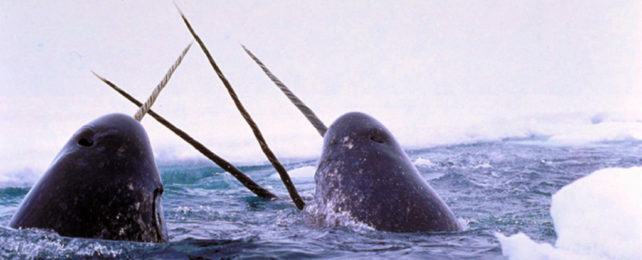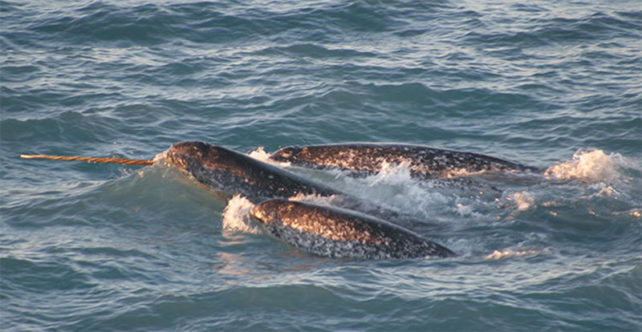Narwhals Are So Weird, Scientists Used Chaos Theory to Explain Their Behavior
Nature01 October 2022By Russell McLendon Narwhals breaching. (NOAA/Climate.gov)
Narwhals breaching. (NOAA/Climate.gov) Narwhals are enigmatic marine mammals, fascinating us with their unique appearance and secretive lifestyles under the Arctic sea ice.
Yet while we still have a lot to learn about narwhals – including how to save some endangered populations from ourselves – scientists have also made a few key discoveries in recent years.
Known for their remarkably deep dives to nearly 2 kilometers (1.2 miles) beneath the surface and dependence on sea ice for their life cycle, the narwhal's motions through the oceans are a complicated affair to keep track of.
Now, with a little help from chaos theory, researchers have now managed to shed light on what seemed like irregular daily behavior in the movements of narwhals off the coast of East Greenland.

"While animal-borne ocean sensors continue to advance and collect more data, there is a lack of adequate methods to analyze records of irregular behavior," says Evgeny A. Podolskiy, a geoscientist at Hokkaido University in Japan and first author of the new study.
In hopes of rectifying that, Podolskiy teamed up with Mads Peter Heide-Jørgensen, a marine biologist at the Greenland Institute of Natural Resources, to develop a new way of finding patterns in the seemingly haphazard habits of narwhals.
Chaos theory is the study of activity that appears unpredictable, yet is governed by strict sets of laws.
Like the proverbial butterfly kick-starting a hurricane with a flap of its wings, it's a case of dependable physics piling up in ways no system can keep track of.
Similarly, like many animals, the meanderings of the narwhal don't make their daily business clear to our human brains.
The new insight into narwhal behavior came from an adult male narwhal, whose movements were recorded over a span of 83 days by a satellite-linked time-depth recorder attached to the animal's back.

Combining their respective specialties in signal processing and biology, Podolskiy and Heide-Jørgensen developed a method that uses mathematical tactics borrowed from chaos theory to make sense of chaotic behavior in dynamic settings.
These techniques can reveal hidden states, known as "attractors," toward which chaotic systems tend to develop, the researchers explain.
They can help scientists find hard-to-detect patterns in some complex processes, including cryptic narwhal behavior.
The tools of chaos theory helped unveil a hidden daily pattern for this narwhal, including novel details about how those habits can be influenced by variables such as seasonal change.
Here's what they found: the tagged narwhal tended to rest closer to the surface around midday, but when he did dive at this time, he plunged down particularly deep.
Dives at twilight and at night occurred in shallower waters but were also more intense, the researchers report, perhaps because the narwhal was hunting for squid.
The narwhal also adjusted his patterns in response to the prevalence of sea ice, the study found.
Not only did he reduce his surface activity at times when sea ice was more abundant, the researchers report, but he also exhibited more intense diving behavior.
Narwhals are not listed as an endangered species by the International Union for Conservation of Nature, but they are still considered vulnerable to human activities, from ship traffic and water pollution to climate change. Some populations may be at risk of disappearing.
The lives of narwhals are intertwined with sea ice, which is rapidly dwindling due to global climate change, and insights about their behavior could be valuable in protecting them.
Chaos theory also could be useful in analyzing animal behavior more broadly, the researchers write.
It might help us understand the challenges faced by other Arctic wildlife due to rising temperatures and fading sea ice, for example, although this approach is still in its infancy.
More research (and more narwhals) will be needed, since the new study is based only on the behavior of one individual.
Nonetheless, it does span "an unusually long period" of nearly three months, the researchers add, noting that comparable records often cover just a few days.
"Our approach is relatively simple to implement," the authors explain, "and can map and label long-term data, identifying differences between the behavior of individual animals and different species, and also detecting perturbations in behavior caused by changing influences."
The study was published in PLOS Computational Biology.


comment 0 Comments
more_vert